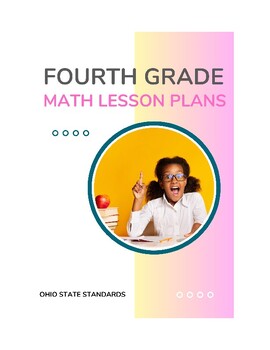Fourth Grade Math Lesson Plans - Ohio Standards
Math Radio
19 Followers
Grade Levels
4th
Subjects
Resource Type
Standards
CCSS4.MD.A.1
CCSS4.MD.A.2
CCSS4.MD.A.3
CCSS4.MD.B.4
CCSS4.MD.C.5
Formats Included
- Word Document File
Pages
78 pages
Math Radio
19 Followers
Description
Welcome to the ultimate resource for fourth-grade math teachers! Introducing the Fourth Grade Math Lesson Plans Bundle, a comprehensive collection of engaging and effective lesson plans designed to empower both educators and students in their math journey.
Why Choose Our Fourth Grade Math Lesson Plans Bundle?
- Aligned with Standards: Our lesson plans are meticulously crafted to align with the fourth-grade math standards, ensuring that you cover all the essential concepts and skills required for student success.
- Comprehensive Coverage: With 27 lesson plans covering a wide range of math topics, you'll have everything you need to teach your students throughout the year. From operations and fractions to geometry and measurement, we've got you covered.
- Engaging and Interactive: Say goodbye to boring math lessons! Our plans are designed to captivate your students' attention and foster their love for math. With hands-on activities, real-world problem-solving tasks, and interactive games, learning becomes exciting and meaningful.
- Differentiated Instruction: We understand that every student learns differently. That's why our lesson plans offer multiple activities at various levels of difficulty to meet the diverse needs of your students. Whether they need extra support or crave a challenge, you'll find activities to cater to every learner.
- Clear Learning Targets and Success Criteria: Our lesson plans include clear learning targets and success criteria (I can statements), empowering students to understand their goals and track their progress. This promotes a growth mindset and encourages self-reflection.
- Differentiation and Extension Activities: Each lesson plan includes unique below-level, at-level, and advanced activities to address the diverse needs of your students. This ensures that every student is appropriately challenged and supported.
- Assessment Ideas: Assessing student understanding is essential. Our lesson plans provide two or three assessment ideas per standard, allowing you to gauge student progress and adjust your instruction accordingly.
- Convenient and Time-Saving: With our ready-to-use lesson plans, you'll save countless hours on lesson preparation. Simply download, print, and teach! Spend more time focusing on your students and their individual needs.
Total Pages
78 pages
Answer Key
N/A
Teaching Duration
1 Year
Report this resource to TPT
Reported resources will be reviewed by our team. Report this resource to let us know if this resource violates TPT’s content guidelines.
Standards
to see state-specific standards (only available in the US).
CCSS4.MD.A.1
Know relative sizes of measurement units within one system of units including km, m, cm; kg, g; lb, oz.; l, ml; hr, min, sec. Within a single system of measurement, express measurements in a larger unit in terms of a smaller unit. Record measurement equivalents in a two-column table. For example, know that 1 ft is 12 times as long as 1 in. Express the length of a 4 ft snake as 48 in. Generate a conversion table for feet and inches listing the number pairs (1, 12), (2, 24), (3, 36),...
CCSS4.MD.A.2
Use the four operations to solve word problems involving distances, intervals of time, liquid volumes, masses of objects, and money, including problems involving simple fractions or decimals, and problems that require expressing measurements given in a larger unit in terms of a smaller unit. Represent measurement quantities using diagrams such as number line diagrams that feature a measurement scale.
CCSS4.MD.A.3
Apply the area and perimeter formulas for rectangles in real world and mathematical problems. For example, find the width of a rectangular room given the area of the flooring and the length, by viewing the area formula as a multiplication equation with an unknown factor.
CCSS4.MD.B.4
Make a line plot to display a data set of measurements in fractions of a unit (1/2, 1/4, 1/8). Solve problems involving addition and subtraction of fractions by using information presented in line plots. For example, from a line plot find and interpret the difference in length between the longest and shortest specimens in an insect collection.
CCSS4.MD.C.5
Recognize angles as geometric shapes that are formed wherever two rays share a common endpoint, and understand concepts of angle measurement:





